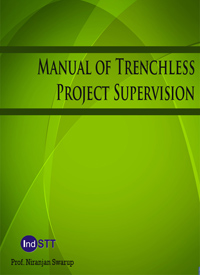|
Trenchless Technology Scope of Works Manual PREFACE
Supervising trenchless project works requires two types of proficiencies, technique specific and overall subsurface construction specific. Former set relates to the knowledge and skill sets and working practices for a particular trenchless technique whereas the latter is for overall subsurface construction works. Aim of this manual is to provide guidelines for overall subsurface construction works. It is designed to be of assistance to the project owners and engineers planning to supervise a trenchless project. For the sake of brevity it is not aimed at providing technique specific proficiencies as the engineers of project owners or third party engineers are required to supervise the works only, and project design, material selection, or equipment selection etc. is not the their work scope. These works are part of detailed engineering of project which needs to be done by professionals trained specifically for such works. Engineers desirous of developing such proficiencies may consider supplementing the information of this manual with other relevant IndSTT / other trenchless publications and books. The manual is structured in a systematic manner with the first section starting with the introduction of the supervisory activity set. This is followed by the introduction of trenchless technology to set the stage. Having provided the introduction the manual moves to discuss issues related to planning of supervision activities followed by actual supervision works and concludes with project closure activities. First section is followed by the second section that discusses technique specific supervision actions. This section follows the format of other IndSTT publications like ‘Schedule of Rates’ or ‘Scope of works manual’ so that the reader is able to get a proper guidance for executing supervision activities. The manual aims to provide recommendations for an appropriate supervisory intervention in trenchless projects. However, the recommendations contained in this manual are of a general nature and should be customised to suit the project under consideration. This customisation has to be done by persons having sufficient knowledge and understanding about trenchless technology and subsurface construction works as omission or commission in the entire activity set is possible and inexperience may prove hazardous. In addition the manual is developed on the basis of the information available with IndSTT presently. As there are numerous individuals and institutions engaged in developing these techniques, revalidation of the information provided in this manual is of extreme importance. IndSTT shall be releasing the subsequent editions of this manual at intervals. Readers must check about the status of such publications. This manual expected to be of immense use to professionals practicing as supervisors of trenchless projects as the guidelines provided herein would help them to undertake the assigned work in a more professional manner and create better subsurface structures. The all-inclusive approach of the manual would help in achieving the least lifecycle cost structures. The guidelines provided in this manual are also expected to help in reducing infructuous resource expenses on a trenchless project through more professional working practices while maintaining project safety. I would like to compliment the reader for considering using this manual for enhancing his proficiencies in the subsurface construction activities through trenchless technology and wish him success in his endeavours. I would also invite the reader to provide me his reactions or inputs on the matter presented in the manual so that necessary revision may be incorporated in the subsequent editions of the manual. Dr.. Niranjan Swarup
|

 Trenchless project supervision is the most critical component of the subsurface structure construction works and any inadequacy would lead to faulty construction. For conventional construction works, error rectification is possible to certain extent however for trenchless construction works the same may not be possible. Even if possible, the rectification extent is much less. The equipment, materials, consumables, worker skills have to be exactly as required, both with respect to quantity and quality, and all of these inputs have to integrated in the works at the opportune time only. One has to do it right the first time itself as there may not be a second chance. Any mistake cannot be corrected once the opportunity window has closed. Work supervision for trenchless projects, therefore, assumes criticality and the trenchless service provider has to treat this as an important part of the project.
Trenchless project supervision is the most critical component of the subsurface structure construction works and any inadequacy would lead to faulty construction. For conventional construction works, error rectification is possible to certain extent however for trenchless construction works the same may not be possible. Even if possible, the rectification extent is much less. The equipment, materials, consumables, worker skills have to be exactly as required, both with respect to quantity and quality, and all of these inputs have to integrated in the works at the opportune time only. One has to do it right the first time itself as there may not be a second chance. Any mistake cannot be corrected once the opportunity window has closed. Work supervision for trenchless projects, therefore, assumes criticality and the trenchless service provider has to treat this as an important part of the project.